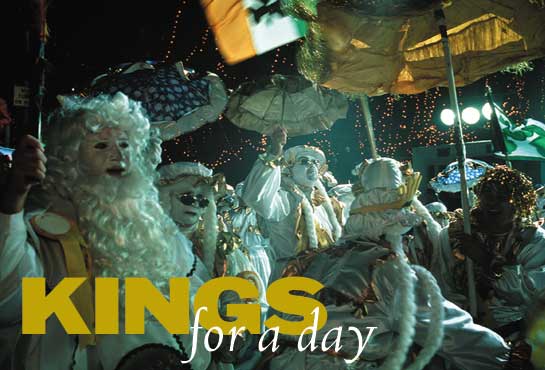

Fantasy and feathers rule in Philadelphia when New Year’s revelers take to the streets in costumes fit for kings. |
| They’re called Mummers (probably after the German word for disguise)—thousands of mostly white blue-collar guys who nearly every January 1 since 1901 have paraded through the city in wild array from head to spray-painted toe. At its peak in the 1940s the parade drew two million spectators. Today fewer than a quarter million come—so few that last year’s route was cut from 2.5 miles (4 kilometers) to ten blocks. The Mummers remain defiantly merry. Says Tom Quinn, who rose before dawn to march, “I’m not out here for anyone but tradition.” Mummers' and guisers' plays were formerly performed throughout most of Great Britain and Ireland, as well as in other English-speaking parts of the world including Newfoundland, Kentucky and Saint Kitts and Nevis. In England, there are a few surviving traditional teams, but there have been many revivals of mumming, often associated nowadays with morris and sword dance groups. Mummers and "guisers" (performers in disguise) can be traced back at least to the Middle Ages, though when the term "mummer" appears in ancient manuscripts it is rarely clear what sort of performance was involved. A key element was visiting people in disguise at Christmas. At one time, in the royal courts, special allegorical plays were written for the mummers each year - for instance at the court of Edward III, as shown in a 14th Century manuscript, now in the Bodleian Library, Oxford. However, apart from being in rhyme, these plays were nothing like the current traditional plays, whose documented history only goes back as far as the mid-18th century. Although usually broadly comic performances, the plays seem to be based on underlying themes of duality and resurrection and generally involve a battle between two or more characters, perhaps representing good against evil. Usually they feature a doctor who has a magic potion which is able to resuscitate a slain character. Early scholars of folk drama, influenced by James Frazer's The Golden Bough, tended to view these plays as debased versions of a pre-Christian fertility ritual, but this view is discredited by modern researchers. In mummers’ plays, the central incident is the killing and restoring to life of one of the characters. The characters may be introduced in a series of short speeches (usually in rhyming couplets) in which each personage has his own introductory announcement, or they may introduce themselves in the course of the play's action. The principal characters, presented in a wide variety of manner and style, are a Hero, his chief opponent, the Fool, and a quack Doctor; the defining feature of mumming plays is the Doctor, and the main purpose of the fight is to provide him with a patient to cure. The hero sometimes kills and sometimes is killed by his opponent; in either case, the doctor comes to restore the dead man to life. The name of the hero is most commonly Saint George, King George, or Prince George. His principal opponents are the Turkish Knight (in southern England and Turkish Champion in Ireland), or a valiant soldier named Slasher (elsewhere). Other characters include: Old Father Christmas (who introduces some plays), Beelzebub, Little Devil Doubt (who demands money from the audience), Robin Hood (an alternative hero in the Cotswolds), Galoshin (a hero in Scotland), etc. Despite the frequent presence of Saint George, the Dragon rarely appears in these plays, though it is often mentioned; a dragon seems to have appeared in the Revesby Ploughboys' Play in 1779, along with a "wild worm" (possibly mechanical), but it had no words to say. In the few instances where the dragon appears and speaks, its words can be traced back to a Cornish script published by William Sandys in 1833. Occasionally, the performers will wear face-obscuring hats or other kinds of headgear, which create the impression of being masked. Some mummers' faces are blackened or painted red by way of disguise. Many mummers and guisers, however, have no facial disguise at all.
|